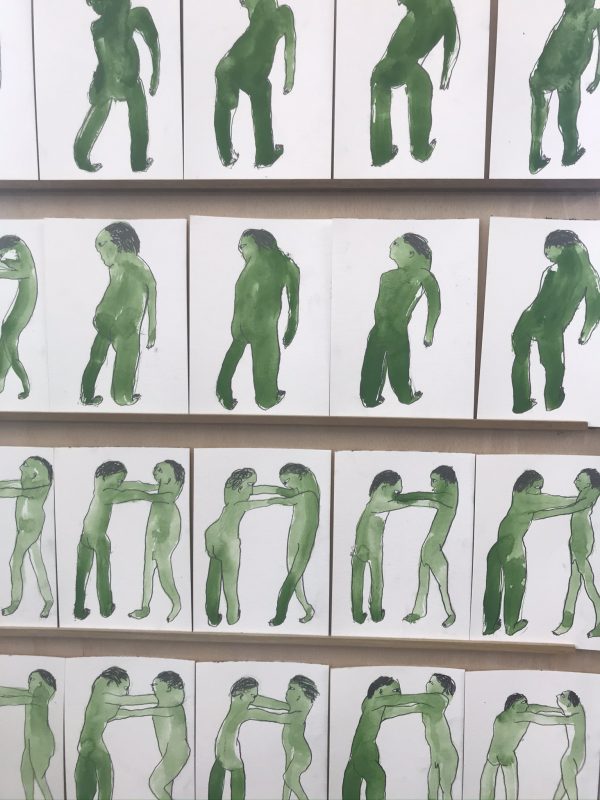Past
Tim Spooner
We were almost in a sad film together
Commonage is pleased to present our first digital project, a newly created work by Tim Spooner We were almost in a sad film together, 2020. The work is accompanied by an interview with the artist below
Pressing Reset: Tim Spooner Interviewed by Séamus McCormack
SMC: Tim I first encountered your work whilst researching online. I was so eager to see your performances, sculptures and drawings not framed by my screen’s edge; to experience the sounds not through digital waves; imagining textures, materiality, scale. I was keen to be close to the oddness of the movements, feel the aura of the uncanny acoustics and the peculiar puppetry, body adornments and extensions. Thankfully that project was able to go ahead, just before everything paused. However, we soon found myself back in that situation, viewing your work through a digital lens. The launch of Commonage, has been delayed. The gallery, which will be located in the basement of a cafe, has had challenges: we began tracking, tracing, and takeaways. Old Bethnal Green’s road works above our heads further complicated our plans. We pressed reset. When the time is right, we will open the exhibition meanwhile this host of characters you have created are waiting in the wings for their spotlight.
This new work made me think of the anxieties caused by ostracism, craving contact with another. With the two figures there’s a confusion in the intent, is it a jab to a jugular or a lustful lunge, you have often played with contradiction in other works too. When I invited you to think how your current work might occupy this online space, can you describe your approach?
TS: I’ve been making a lot of drawings in series, drawing the same drawing again and again in order to discover what the drawing is of. In keeping the process quick, out of control and fragile, the similarities and the differences between each picture become very clear, and the relationship between the figures stays ambiguous and doesn’t settle. With previous series of pictures I might either choose one drawing to represent the whole set, or present all of them in a line or a grid.
So showing a series like this, as a video of each drawing in quick succession, is a new way. They work as a kind of animation that sometimes animates and sometimes doesn’t. I’m interested in the distancing effect of glimpsing each picture for 1/12 of a second at a time. The figures aren’t really performing an action, they’re in a moving stasis, always almost touching but never doing it.
SMC: Ideas of touch and sensory awareness are explored in this new series of drawings, (and sculptures that we will experience soon) through the materials employed, scale, and the sampling of sound. In our current moment, where our awareness of touch is amplified, your amorphous figures seem to crave social interaction, what are your thoughts on how the works could be read within our current context of isolation, quarantine and social distancing which have all become omnipresent?
TS: The work was all made during the first months of lockdown. At the time I didn’t notice, but as the work built up it became clear that it was a thing of its time. I found myself drawing and making plainly figurative work for the first time in a long instance. I worked with materials that I already had around, that I’d gathered over years, all attractive to me because of what they offered to the sense of touch. I like materials where you can imagine the feel of them by the sight them.
I was interested in the difference between solos, duos and trios of figures and the points of connection or closeness of different parts of their bodies. The small gaps, touching and bleeding turned out to be what the work was about.

SMC: Has the space of making, your domestic space during lockdown, had an impact on your approach or your use of materials? How has it felt to create work in a moment of extended uncertainty of when it could be seen?
TS: At the beginning of lockdown I quickly moved a chosen selection of materials home so I could carry on working. Velvet, fake fur, mouldable plastic, stuffing, a sewing machine, watercolours and postcards of watercolour paper. The limitation and smallness of the materials produced a new kind of work and a more contained structure to explore inside. I used each new picture or object as the seed for making the next one so that the process could be self-propelling. The body of work is quite closed in on itself like a bat or echo flapping or bouncing around inside a cave.
SMC: I would say that your background in theatre is embedded in your approach to sculpture and drawing, can you comment on how these objects relate to your performative practice?
TS: All the performance work is an experiment in testing and demonstrating how materials behave, with me as a helper. I’m looking at how the material of the human body and other nonhuman materials can connect or relate to each other through shared tendencies or desires. In a way the non-live work represents the aftermath of experiments rather than experiments in motion.
Tim Spooner’s exhibition at Commonage A Wave in a Cave was our inaugural exhibition.